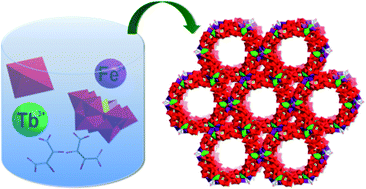Supramolecular nanotubes constructed from 3d–4f heterometallic sandwiched polyoxotungstate dimers†
Abstract
By the hydrothermal technique, a series of organic–inorganic hybrid polyoxometalates (POMs) Hx(H2en)y [Fe2Ln(β-PW10O37)2(Tart)]·nH2O (Ln = La3+, (x, y, n) = (5, 3, 9) for 1; Ln = Ce3+, (x, y, n) = (5, 3, 7) for 2; Ln = Sm3+, (x, y, n) = (3, 4, 25) for 3; Ln = Tb3+, (x, y, n) = (3, 4, 21) for 4; H2Tart = tartaric acid) have been obtained and structurally characterized by elemental analyses, IR spectroscopy, thermogravimetric analyses and single-crystal X-ray diffraction. The common structural characteristics of 1–4 consist of a [Fe2Ln(β-PW10O37)2(Tart)]9− unit, in which transition metal and lanthanide ions co-exist in the vacant site of divacant [β-PW10O37]9− with the assistance of Tart ligands. It should be pointed out that 1–4 represent the first 3d–4f heterometallic cluster sandwiched phosphotungstate dimers, [Fe2Ln(β-PW10O37)2(Tart)]9−, linked by Fe–O–Ln–O–Fe bonds. Furthermore, 3 and 4 exist as rare supramolecular nanotubes built from the organic–inorganic hybrid 3d–4f POM units. Also, the photochromism and optical properties of 1–4 have been studied.


 Please wait while we load your content...
Please wait while we load your content...